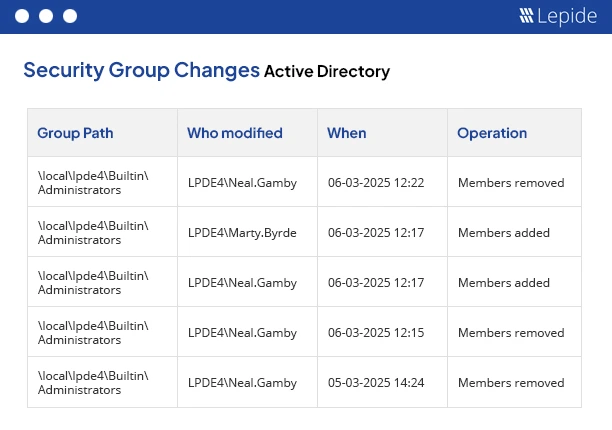
Real time alerts are a vital part of any effective Active Directory secure strategy. They enable IT teams to detect and respond to unwanted events and changes quickly and directly. In this blog, we’ll explore just how impactful real time alerts can be and give you some examples of what the most effective real time alerts might be for your AD environment.
What Makes Real-Time Alerts So Important?
There are numerous reasons why Active Directory (AD) real-time alerts are essential. Here’s why they’re important:
- Instant Threat Detection: Real-time monitoring shortens the interval between when an incident occurs and when it is detected. Traditional periodic reviews include the hourly or daily log reviews that allow the hazards to grow unnoticed without detection.. Real-time alerts continuously monitor the systems and networks, spotting doubtful activities almost on an instant basis so that immediate action can be taken before any further damage.
- Mitigation of Risks: The teams may react swiftly, with actions such as isolating impacted systems, disabling compromised accounts, or making changes because of the malicious intent, by means of real-time alerts. With continuous monitoring, the organizations meanwhile could identify anomalies, like an unusual increase in logins or data usage, before these evolve into major concerns. This is good because it presents the opportunity for teams to remedy systems or place countermeasures proactively.
- Compliance Assurance: There are some regulations that require timely detection and reporting of an issue, e.g., GDPR, HIPAA, and PCI-DSS. Real-time alerts provide continuous visibility and ensure ongoing supervision; provide an audit trail thereby making it easier for compliance activities to be undertaken. Logs generated by real-time alerts can serve as evidence of compliance with regulatory requirements.
- Enhance Operational Efficiency: Real-time alerts contribute to operational efficiency by identifying potential performance bottlenecks and other problems that might have an impact on the performance of the AD environment. By drawing attention to these problems before they cause issues, an organization guarantees smooth and efficient operation of its AD infrastructure.
- Preserving Security and Integrity: Real-time monitoring maintains security and integrity with the continuous supervision of Active Directory processes. The replication status, domain controller health, and other vital services are observed. In the case of performance problems, service interruptions, or other abnormalities that might be signs of an AD infrastructure problem, administrators can be alerted through these alerts.
- Enhanced Visibility: Continuous monitoring provides 100% visibility into who is doing what and at what time inside Active Directory, file systems, or even mailbox environments. The alert comes with user and file level context, not a generic flag, so you can investigate accurately. Real-time monitoring provides straight clarity about AD activity to help proactively identify trends or patterns and security gaps.
- Faster Detection and Response: Real-time alerts provide teams with the ability to respond quickly to signs of threats by decreasing dwell time and minimizing risk before things develop into large situations. It is crucial to have this quick feedback loop, even a minor delayed response of a few minutes can mean the spread of ransomware, loss of data, legal issues, and financial impact. With real-time alerts, suspicious behaviours like unauthorized access attempts, privilege escalation, or strange login behaviours can be quickly identified and investigated so these risks can be mitigated before they worsen.
- Automated Response: Alerts enable immediate awareness of business-critical events like blocking suspicious IP addresses or disengaging compromised user accounts. Alerts enhance security and situational awareness while contributing to rapid containment and minimizing future risks. Alerts do not just tell you. They allow administrators to ‘freeze’ accounts, undo actions, and quarantine systems from anywhere they have access, all while allowing administrators to maintain event containment capabilities via Lepide’s real-time integration with your response processes or mobile applications.
- Better Security Posture: Real-time alerts create a unified, proactive security environment by aggregating signals from systems, files, identities, and permissions. They are essential for SIEM workflows, provide operational resiliency, allow you to identify blind spots earlier, and build on top of your other environments.
- Meeting Compliance Requirements: Many industries require regular audits and strict access control. Real-time notifications and comprehensive documentation however go a long way in demonstrating compliance with regulations like ISO 27001, HIPAA and more. Real-time alerts provide detailed logs of Active Directory changes and significantly reduce the burden on IT teams, as well as simplify the audit process. AD changes provided by real-time alerts demonstrate to regulatory auditors not just a detection, but substantive evidence of a timely investigation and remediation.
How Does Not Having Real-Time Alerts Affect Security?
Without timely alerts, security is compromised by slowing down detection and response time, the chances of breaches increase and the risk of alert fatigue facing security teams is likely to worsen. Here’s how:
- Increased Risk of Alert Fatigue: When security teams experience multiple non-critical or delayed alerts, they will become uninterested, or respond more slowly to real threats, or even ignore the alerts. This is known as alert fatigue and can ultimately mean more successful intrusions and diminish the value of the security process.
- Increased Damage and Financial Losses: The operational and financial impact is directly increased by the extended real-time. According to IBM, breaches found more than 200 days later cost 37% more than those found sooner, and the average cost of a breach in the US is currently above $8 million. Business interruptions, fines, forensic analysis, and legal fees all increase over time.
- Slower Threat Detection and Extended Dwell Time: Without real-time alerting, attackers can stay undetected for significantly longer called “Dwell time”. Each additional day allows intruders to dig deeper, steal more data, expand access, and embed persistence, and exponentially increase remediation cost and expansion.
- Attacker to Evade Detection: Attackers benefit from not being interrupted by immediate notifications or real-time alerts of their network presence. Without immediate notifications, attackers can move laterally, acquire rights, and gradually collect data. Much of the breach may have been maliciously started before any routine monitoring occurs.
- Attacker to Evade Detection: Attackers benefit from not being interrupted by immediate notifications or real-time alerts of their network presence. Without immediate notifications, attackers can move laterally, acquire rights, and gradually collect data. Much of the breach may have been maliciously started before any routine monitoring occurs.
Best Real Time Alerts with the Lepide Data Security Platform
Lepide Data Security Platform can generate real-time alerts for a wide range of activities. Below are some of the key alerts it produces for Active Directory:
- Potential Brute Force Attacks: Lepide keeps track of unsuccessful attempts to log in to Active Directory. When a user account experiences a certain number of unsuccessful login attempts in a brief period of time, a warning titled “Potential Brute Force Attack” is triggered. Lepide Data Security Platform can react automatically to prevent unwanted access by locking the account or requiring a password reset.
- Mass Delete Behaviour (Organizational Unit): When a significant number of deletions take place within an OU, this real-time warning is set off. Malicious attempts to destroy Active Directory or mass provision accounts are frequently the cause of such alerts. Lepide provides real-time alerts using a combination of threshold based rules, user behavior analytics, and anomaly spotting, allowing administrators to stop the process before important accounts or infrastructure are lost.
- Mass Delete Behaviour (User): This is triggered when a single user account quickly removes a large number of files, objects, or folders. It can be a sign of harmful insider action or the deletion of data using a hacked account. Based on behaviour baselines, Lepide highlights this typical pattern to initiate an automatic remediation cycle or an immediate investigation.
- Potential Business Disruptions: Any action that could interfere with business operations, like the removal of important system accounts, sudden mass changes, altering permissions for important roles, or turning off services, all can trigger a real time alert. Multiple low-level events are combined by Lepide Detect’s threat model engine to alert users to threats before they cause disruption to business continuity. For example, account lockouts caused by repeated unsuccessful login attempts are considered crucial signs of potential business disruptions. Lepide automatically connects these lockouts with other questionable activity to identify possible credential abuse or brute-force attacks. When user or service accounts are locked out, administrators are notified right away, allowing for quick inquiry and unlocking to avoid downtime and preserve business continuity.
- Increased Threat Surface Area: Privilege elevations, such as adding new users to high-privilege groups, nested cases of administrative privileges, and increasing levels of access across multiple servers/file shares, can trigger real time alerts. This helps to limit the attack surface and stop unchecked privilege creep.
- Potential Password Compromises: One of the built-in real-alerts in Lepide Detect uses threat modelling and AI-driven baselines to identify unusual activity connected to passwords. It monitors trends such as automated password reset alerts, password expiration tracking, and abrupt bulk password resets across numerous accounts. Additionally, it assists users who have weak or never-expiring passwords and those who log in at odd hours by enabling prompt risk mitigation measures.
Protect your environment with real-time alerts and automated threat response. Want to see it how? Schedule a demo with our experts, or download a free trial now.

